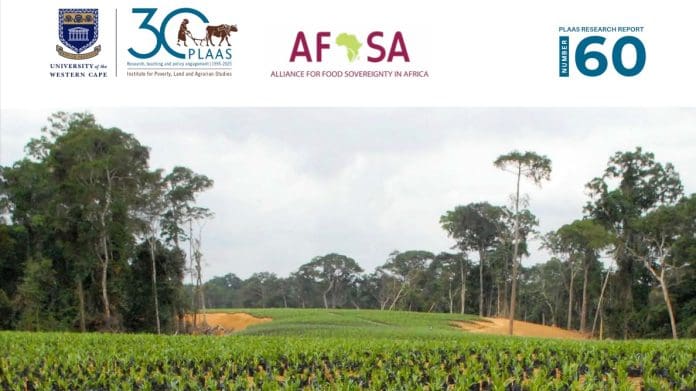Copyright ghanamma

A comprehensive research report released by the Institute for Poverty, Land and Agrarian Studies (PLAAS) at the University of the Western Cape challenges persistent narratives about vast expanses of unused African land, warning that the continent faces an intensifying squeeze from multiple competing demands including agriculture expansion, mining, urbanisation, and carbon offset schemes. The 110 page report, titled Land Availability and Land Use Changes in Africa, dismantles five core assumptions underlying major development initiatives, including the African Development Bank’s (AfDB) ambitious Feed Africa programme targeting 25.7 million hectares for industrial agriculture. The research demonstrates that claims about Africa possessing 65 percent of the world’s uncultivated arable land fundamentally misunderstand how African communities currently use their territories. Analysis reveals that when considering land quality and accessibility, only 50 million to 100 million additional hectares could potentially be farmed, far less than commonly cited figures. Much of the land characterised as unused or available actually supports grazing, shifting cultivation, gathering of wild foods, spiritual practices, and critical ecosystem functions including carbon sequestration and biodiversity conservation. Dr Phillan Zamchiya and Charity Rusere, the report’s lead authors, argue that land classifications as empty, vacant, underutilised, or marginal reflect colonial era thinking that ignores diverse local land uses and customary tenure systems. The research draws on satellite data analysis, spatial autocorrelation studies, and interviews with smallholder farmers across Zambia, Mozambique, South Africa, and Zimbabwe. Between 2001 and 2023, Africa recorded 96 percent of global growth in cultivated agricultural land, representing 75 million hectares out of a total 78 million hectares worldwide. This expansion came primarily through converting forests, which lost an estimated 82 million hectares during the same period, along with grasslands and other natural vegetation. The report identifies multiple actors driving land use changes. Gulf Cooperation Council countries, particularly the United Arab Emirates and Saudi Arabia, are pursuing extensive agricultural and carbon offset projects. Chinese companies control significant portions of Africa’s cobalt and copper mining operations while expanding timber imports and infrastructure development through the Belt and Road Initiative. Western corporations dominate carbon credit markets, with companies including Microsoft, Meta, Amazon, and Shell purchasing credits from African projects. African governments themselves facilitate these changes through policies promoting special economic zones, large scale agricultural investments, and carbon market participation. The Africa Carbon Markets Initiative launched at the 2022 Conference of the Parties meeting in Egypt targets producing 300 million carbon credits annually by 2030, potentially covering millions of hectares. Satellite projections indicate that forest land and grassland conversions to cropland will accelerate significantly through 2100, with forest areas declining by 38 percent in some regions. The Democratic Republic of the Congo, Angola, Tanzania, Mozambique, Sudan, Nigeria, and Zambia account for 80 percent of forest losses. Population growth compounds these pressures. Africa’s population is projected to reach 2.5 billion by 2050, driving demand for food, housing, and infrastructure. Urbanisation rates are accelerating, with nearly one billion additional people expected to live in African cities by mid century, consuming agricultural land for expansion. Mining for critical minerals including lithium, cobalt, and copper for renewable energy technologies is converting additional vegetation land. In Zimbabwe, lithium mining projects cover thousands of hectares, while Zambia’s copper operations continue expanding. The Solwezi copper mining district in Zambia saw mining areas increase by 4,706 hectares between 1995 and 2019, converting forestland, cropland, and barren areas. The report challenges assumptions underlying technology driven agricultural development. The Alliance for a Green Revolution in Africa spent over a decade promoting improved seeds, synthetic fertilisers, and modern inputs with limited success. The number of severely hungry people increased by 31 percent in focus countries since the alliance’s founding in 2006. Despite claims that small scale agriculture cannot feed Africa, the research notes that 33 million smallholder farmers manage 80 percent of the continent’s farmland and contribute up to 80 percent of sub Saharan Africa’s food supply. The authors argue that improving household food security requires more than increasing crop production metrics, emphasising that redistributive politics enabling nutritious food access for poor and marginalised populations must be central. The report proposes policy alternatives including shifting from high input industrial agriculture toward agro ecological farming models that protect soil health, biodiversity, and smallholder livelihoods. Recommendations include producing more food on existing farmland rather than expanding cultivation, avoiding land intensive carbon market schemes in favour of direct fossil fuel emission reductions, and reducing demand for critical minerals through recycling and resource efficiency. Critical to these recommendations is strengthening customary land rights and implementing Free, Prior and Informed Consent principles before development projects proceed. The report emphasises that most land use changes occur without meaningful consultation with indigenous people and local communities who depend on these territories for livelihoods. Professor Ruth Hall from PLAAS, who facilitated related discussions at the Sixth Conference on Land Policy in Africa held in Addis Ababa from November 10 to 14, stated that the idea of land abundance represents a colonial fiction that refuses to disappear. She emphasised that research shows Africa’s lands are already intensively used and deeply valued by millions of rural people, with the real challenge being protecting land for communities and future generations rather than unlocking it for investors. The report warns that continuing current trajectories of land conversion will lead to ecosystem imbalance, biodiversity loss, reduced carbon storage, and threats to livelihoods. Forest conversion drives deforestation rates of 3.9 million hectares annually in Africa, the highest globally. Grassland conversion affects water access for livestock and wildlife, fragments habitats, and converts ecosystems into net carbon emitters. Timber demand from China, which imports more than three quarters of Africa’s timber exports, contributes to deforestation across Cameroon, Gabon, Republic of the Congo, Central African Republic, Democratic Republic of the Congo, Mozambique, and Zambia. China imported 1.46 million cubic metres of African timber in the first half of 2024, representing 16 percent growth compared to the previous year. The research arrives as African leaders finalise Framework 2.0 of the African Union’s antimicrobial resistance strategy and as the continent prepares to host the 5th Global High Level Ministerial Conference on Antimicrobial Resistance in Abuja, Nigeria in June 2026. While not directly related to land policy, both initiatives reflect broader continental governance challenges around resource management and international pressures. The authors conclude that Africa’s first land policy framework provided a blueprint but that the sequel must deliver measurable results. With population growth, climate change, and competing international interests intensifying pressure on African land, the report calls for coordinated action from local community organising through continental policy advocacy to protect land rights and ensure sustainable resource governance. The Institute for Poverty, Land and Agrarian Studies produced the report in partnership with the Institute for Agriculture and Trade Policy and the Oakland Institute. The research contributes to ongoing debates about African development pathways and the role of external actors in shaping the continent’s agricultural and environmental futures.



